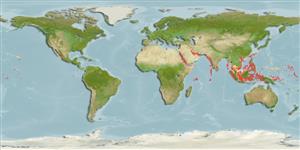>
Eupercaria/misc (Various families in series Eupercaria) >
Haemulidae (Grunts) > Plectorhinchinae
Etymology: Plectorhinchus: Greek, plektos = plaited + Greek, rhyngchos = snout (Ref. 45335).
More on author: Rüppell.
Environment: milieu / climate zone / depth range / distribution range
Écologie
marin; saumâtre récifal; profondeur 2 - 50 m (Ref. 9710). Tropical; 30°N - 7°S
Indo-West Pacific: Red Sea and Madagascar to Fiji and Micronesia; north to Ryukyu andn south to the Great Barrier Reef and New Caledonia.
Taille / Poids / Âge
Maturity: Lm ? range ? - ? cm
Max length : 100.0 cm SL mâle / non sexé; (Ref. 48635)
Épines dorsales (Total) : 13; Rayons mous dorsaux (Total) : 17 - 18; Épines anales: 3; Rayons mous anaux: 7.
Found in clear lagoon and seaward reefs. Juveniles in brackish habitats or shallow turbid coastal areas (Ref. 9710). Adults usually solitary, occasionally in pairs; on deep reefs or with sea mounts (Ref. 48635). At Palau, aggregates to spawn about once a year around new moon of April or May (Ref. 37816).
Life cycle and mating behavior
Maturities | Reproduction | Spawnings | Egg(s) | Fecundities | Larves
Oviparous, distinct pairing during breeding (Ref. 205).
Myers, R.F., 1991. Micronesian reef fishes. Second Ed. Coral Graphics, Barrigada, Guam. 298 p. (Ref. 1602)
Statut dans la liste rouge de l'IUCN (Ref. 130435)
Menace pour l'homme
Harmless
Utilisations par l'homme
Pêcheries: commercial; Aquarium: Commercial
Outils
Articles particuliers
Télécharger en XML
Sources Internet
Estimates based on models
Preferred temperature (Ref.
123201): 25.4 - 29.2, mean 28.4 °C (based on 634 cells).
Phylogenetic diversity index (Ref.
82804): PD
50 = 0.5000 [Uniqueness, from 0.5 = low to 2.0 = high].
Bayesian length-weight: a=0.01380 (0.00670 - 0.02842), b=3.00 (2.83 - 3.17), in cm total length, based on LWR estimates for this Genus-body shape (Ref.
93245).
Niveau trophique (Ref.
69278): 4.0 ±0.66 se; based on food items.
Résilience (Ref.
120179): Très faible, temps minimum de doublement de population supérieur à 14 ans (Preliminary K or Fecundity.).
Fishing Vulnerability (Ref.
59153): High to very high vulnerability (73 of 100).
Nutrients (Ref.
124155): Calcium = 20 [7, 40] mg/100g; Iron = 0.418 [0.215, 0.807] mg/100g; Protein = 19.8 [17.9, 21.6] %; Omega3 = 0.126 [0.068, 0.218] g/100g; Selenium = 36.9 [20.1, 63.4] μg/100g; VitaminA = 58.9 [20.1, 175.5] μg/100g; Zinc = 1.04 [0.71, 1.53] mg/100g (wet weight);
